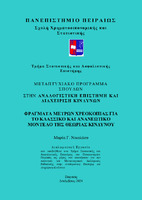Φράγματα μέτρων χρεοκοπίας για το κλασσικό και ανανεωτικό μοντέλο της θεωρίας κινδύνου
Bounds for ruin measures in the classical and renewal risk model

View/
Keywords
Φράγματα μέτρων χρεοκοπίας ; Άνω και κάτω φράγματα για τη δεξιά ουρά σύνθετων κατανομών ; Φράγματα για κλάσεις αξιοπιστίας της κατανομής του ύψους της ατομικής ζημιάς ; Εκθετικά φράγματα ; Φράγματα Pareto ; Ανανεωτικό μοντέλο θεωρίας κινδύνου ; Σύνθετη γεωμετρική και ανάλογες κατανομές ; Περίπτωση κλασικού μοντέλου χρεοκοπίας ; Περίπτωση ανανεωτικού πρότυπου ; Περιγραφή άνω και κάτω φραγμάτων ; Κλασσικό μοντέλο Χρεοκοπίας σε συνεχή χρόνο ; Άνω και κάτω εκθετικά φράγματα και φράγματα τύπου ParetoAbstract
This paper deals with the probability bounds of a large claim size in the case of complex distributions that model this risk. We present the cases of individual demand distributions with an analytical moment generator function and distributions in which the moment generator function is not defined. Such distributions are those with heavy tails and although the calculation of the probability bounds is quite complex (either with asymptotic techniques or not), nevertheless the importance of limiting the probability to upper and lower bounds is of utmost importance for insurance companies in the matter of future risk management.
Aggregate risk is doubly stochastic in the sense that it is composed of a random number of random individual risk sizes that are either simulated or not from the same distribution. The probability of the total risk - which is modeled by a complex distribution - is either given analytically (through a distribution) or through bounds with asymptotic (as long as the magnitude tends to perpetuity) or non-asymptotic techniques.
A more complete knowledge of the properties of the individual risk distribution may lead to an optimal calculation of the barriers of the requested probability and contribute to the avoidance of the bankruptcy case which is studied here in the light of the classical model and the renewal standard model.


